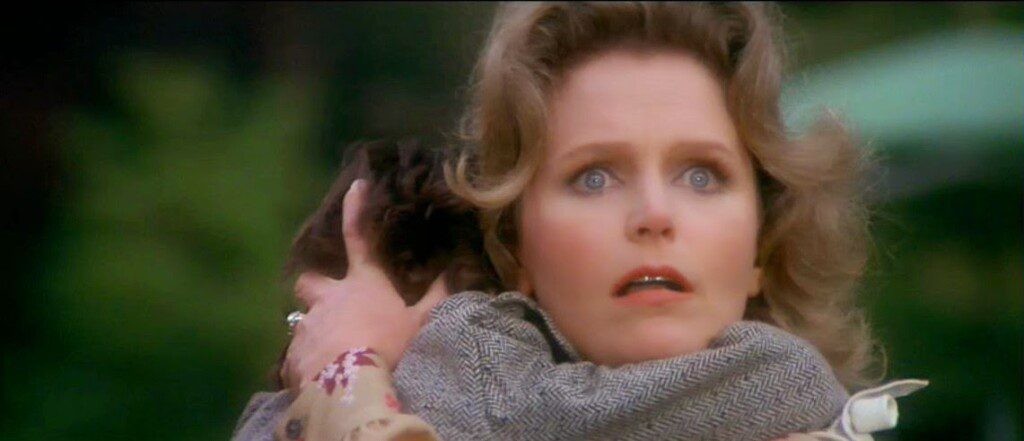“God has given you a son.”
I’ve been doing 31 Days of Fright for almost a decade now – sometimes sporadically, I’ll admit – so how am I just now getting around to watching The Omen? Out of all the obscure-as-hell movies I’ve written about – Emelie, Sweetheart, Honeymoon, etc. – I managed to ignore one of horror’s core documents. Richard Donner’s film is oozing with atmospheric dread, it’s bleak as hell, and does something most horror can only feint at: it makes you believe in pure evil. This is a classic for a reason.
To give you an idea of The Omen’s grimdark approach, the film starts with a dead baby. Of course this happens off-screen, but it’s no less haunting for that (Robert Thorn, played by Gregory Peck, hears a wizened voice in his head saying, “He breathed once, and then no more”). Robert makes an impossible decision: adopt an orphaned boy (whose mother died at the exact moment that Robert’s son did) and lie to his wife. These are the first frenzied minutes of The Omen; coming, as they do, on the heels of a credits sequence set to an absolute monster of a theme from Jerry Goldsmith (who won his only Oscar for this), these opening scenes set expectations for the rest of the film, which thankfully delivers.

The boy, Damien, lives a more or less ordinary life with Robert and his wife, Katherine. That is until his fifth birthday party, when his nanny becomes entranced by a dog then promptly hangs herself from the manor’s eave. (This is also where we get the film’s iconic line, “It’s all for you!”) Normalcy literally comes crashing down, and while the party turns hysterical, Damien barely reacts. Harvey Stephens, as Damien, isn’t a particularly strong actor, but his blankness ends up as more of an asset than one might assume. There’s an eerie stillness to his nonreactivity, and because John Seltzer’s script calls for very little dialogue or emotion from Damien, nothing is revealed that we could use to demonize or humanize him.
The Omen is one of the quintessential “evil child” movies, but describing it as such is, to me, reductive. Yes, Damien is the Antichrist – but does he know that? At the zoo with his mother, he seems genuinely puzzled when the giraffes flee from his presence, and equally terrified when their car is attacked by baboons. Damien is a lot like these animals. At this age, evil things happen because of him, but not by his actions. Like the giraffes and baboons, it’s part of his nature: because he exists, the world is a worse place. This is echoed throughout Peck’s performance; there’s a stoicism to Peck that always served him well, and here it makes him seem like a man out of time, unprepared for the new reality unfolding in front of him.
Arguably the secret weapon of the film is David Warner, playing a photographer named Keith Jannings. We first meet Jannings at Damien’s birthday party; when another photographer asks Jannings if he’s run out of film, he quips, “I’m saving the rest for his canonization.” There’s a kind of hangdog cynicism to Warner’s performance, a world-weariness that at first reads as sinister, especially as he continues to pop up around Robert’s life. When he and Robert finally link up – Jannings has a photo that presages the impalement of a priest – The Omen swerves into mystery territory, by far the best part of the film.

Donner stages several incredibly effective sequences, the most harrowing of which is when Robert and Jannings are attacked by a pack of dogs in a windblown Italian cemetery. Just writing that sentence gave me chills. So much of The Omen is just a pleasure to look at and soak in; so much care has been put into crafting the darkness that permeates every cel. Like all successful horror films, The Omen has a slew of sequels, which I’m not all too interested in exploring (The First Omen, however, is incredible). I’m fine with doing nothing to change the visceral, inchoate reaction I had to Donner’s perfectly preserved slice of hell.
Here’s an illustrative example: in the film’s climax, Robert returns to his home, tasked with killing Damien in a church, which will truly drive out the evil housed within him. Robert enters as quietly as possible, wanting to wake neither Damien nor his governess, Mrs. Baylock. He does, however, manage to wake up Damien’s watchdog, a literal hellhound whom Robert has spent the film trying to get rid of. The dog comes downstairs, forcing Robert to hide; we wince when he steps on a creaky floorboard. The scariest dog this side of Cujo investigates – there’s an intelligence, a purposefulness to the route he takes through the house. He’s not wandering aimlessly, the way your dog or mine will do. He has a target. He’s hunting.

